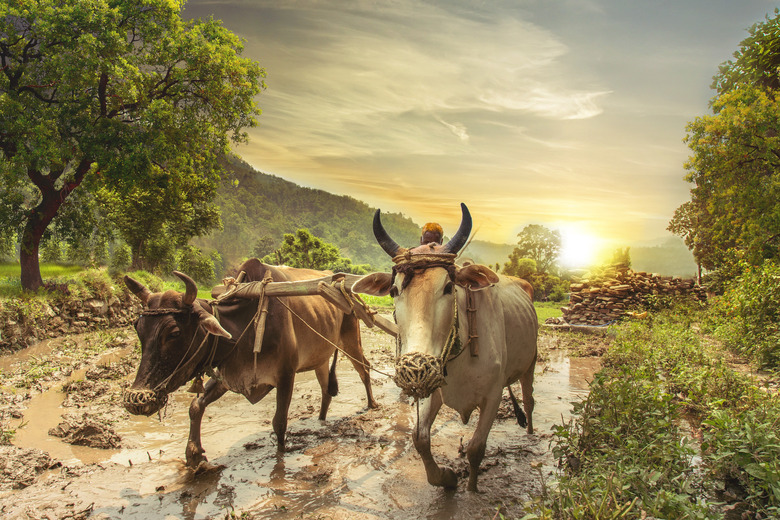Importance Of Plants & Animals In Human Life
Plants and animals have played an important role in human life for as long as they've all existed. In fact, without the plants and animals that humans have used for food, labor, tools and companionship over countless generations, society could not have advanced to the point it has today.
TL;DR (Too Long; Didn't Read)
Humans have used plants and animals as food, labor, tools and companions. People would not have survived without the help of several species of plants and animals.
Plants and Animals as Food
Plants and Animals as Food
Human beings hunted animals and gathered plants for food long before the formation of permanent settlements. Some of the earliest animals used for food by humans were insects, fish, wild pigs, and deer or antelope. Plants used for food included berries, mushrooms, and various seeds and nuts. Before the invention of agriculture or farming, gathering and eating plants was just as dangerous, in a sense, as hunting animals for meat. Many plants are toxic to humans, and simply picking the wrong berries or mushrooms for a meal could seriously injure or kill that person.
As mankind progressed and agriculture increased, plants like wheat and rice began to make up the backbone of the human diet. A person's location dictated what sort of fruits, vegetables and grains one was able to grow. As humans began to travel the seas and explore new continents, different cultures borrowed agricultural techniques from one another and brought back plants and seeds. New plant hybrids began to develop, yielding larger, more reliable crops.
Humans also domesticated a variety of animals for use as food. Pigs, cattle, goats and sheep were raised by people and diminished and eventually eliminated the need for constant hunting. Today, these same animals are used for meat, milk and cheese.
Plants and Animals Put to Work
Plants and Animals Put to Work
Plants and animals have been used by people to help with a variety of tasks for millennia. Plants were used to create clothing, such as straw hats and woven cotton textiles. Clothing helped to shield human skin from the sun and to help regulate body temperature. Animal fur and pelts were also used to create clothing that allowed people to safely hunt, work and live outdoors, especially in colder climates.
Animals played an important part in all sorts of labor-intensive tasks up until the development of advanced technology. Horses provided fast transportation before the development of cars. They could pull trees from the ground, pull plows to till fields and carry building materials long distances, allowing people to build tougher homes and barns in a wider variety of places. Dogs assisted people in hunting. Certain breeds were developed to hunt in different ways, from terriers that dug up rodents and other small pests from the ground to pointers that helped hunters locate birds or deer in tall brush. In some cases, dogs could even be trained to chase, kill and retrieve animals at a hunter's command, making in unnecessary for humans to risk injury in order to obtain meat.
In parts of the world where the latest technology is unavailable, animals are still used to perform tasks that would otherwise be difficult or impossible.
Plants and Animals Used as Tools
Plants and Animals Used as Tools
Animal bone could be carved into knives, spears and other useful instruments. Animal bladders were sometimes used to create bags, while hollowed-out horns from animals like rams could be used to transmit sounds over long distances. Wood from trees was used to build everything from the bodies of spears to hunting bows. Later on in human history, wood was used in the creation of the first guns. Bird feathers were often used to balance arrows, or to add warmth to clothing, especially moccasins.
Early hunters usually tried to use every part of an animal's body, if possible, to maximize its usefulness. If an animal such as a buffalo was killed, the buffalo's own horns and skull fragments might be used to remove fur from the hide so that the hide could be tanned.
Plants and Animals Welcomed as Companions
Plants and Animals Welcomed as Companions
Human beings are social creatures that crave companionship. In addition to providing us with food, labor and tools, plants and animals have given us their company over generations, helping to comfort us and make us more productive.
Recent research from the University of Queensland has shown that adding a plant to one's workspace can increase productivity up to 15 percent. Watching fish swim in tanks has long been shown to lower blood pressure. Tending plants in a garden can lead to a sense of fulfillment, while placing them indoors can lead to less overall stress.
Of all domesticated animals, dogs and cats have offered mankind by far the most companionship over generations. Dogs were originally domesticated to help humans hunt, but quickly became like members of the family for their owners. Cats were domesticated to kill mice, rats and other pests. But soon their companionship led humans to keep cats inside their homes, even if there was no need for the animals to hunt. This newfound domesticated animal companionship was good news for mankind, since scientists have now shown that pet owners, especially dog owners, live longer than those who do not keep animals as companions.
Humans still use plants and animals for food, labor, tools and companionship nowadays, though in different capacities. Without these partnerships, the world would be vastly different.
Cite This Article
MLA
Cook, Maria. "Importance Of Plants & Animals In Human Life" sciencing.com, https://www.sciencing.com/importance-plants-animals-human-life-5541170/. 17 April 2018.
APA
Cook, Maria. (2018, April 17). Importance Of Plants & Animals In Human Life. sciencing.com. Retrieved from https://www.sciencing.com/importance-plants-animals-human-life-5541170/
Chicago
Cook, Maria. Importance Of Plants & Animals In Human Life last modified March 24, 2022. https://www.sciencing.com/importance-plants-animals-human-life-5541170/
